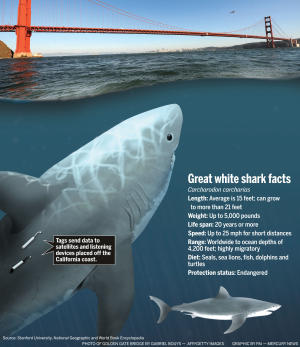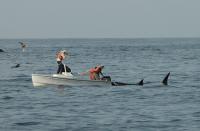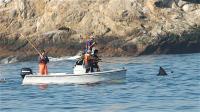
Nov 3, 2009
Great white sharks at times enter San Francisco Bay
by Paul Rogers
Windsurfers, fishing boats and cargo ships aren't the only traffic in San Francisco Bay. Great white sharks are there sometimes, too.
In what is believed to be the first scientific confirmation of white sharks in San Francisco Bay, researchers from Stanford University, the University of California-Davis and other organizations put satellite and acoustic tags on 179 white sharks in Northern California waters from 2000 to 2008. They found that most of the sharks migrated thousands of miles every year, from California to as far away as Hawaii, and five swam underneath the Golden Gate Bridge in 2007 and 2008 and into bay waters.
It isn't known exactly where the sharks went once in the bay, only that their acoustic
tags were detected by receivers anchored to the bay floor between the Golden Gate Bridge and Alcatraz Island.
"All we know so far is that they are poking their heads across the Golden Gate," said Barbara Block, a professor of biology at Stanford's Hopkins Marine Station in Pacific Grove who helped lead the tagging study. "I doubt they are coming in very far because they are salt water animals."
There are nearly a dozen species of sharks known to live in the bay, including leopard, sevengill and other, mostly docile bottom-dwelling varieties. Researchers have wondered for years whether great whites — apex ocean predators that can reach 15 feet long or more and weigh 4,000 pounds — are there too. But there have been no documented cases of white sharks ever attacking seals, sea lions or other animals in the bay, let alone people, said John McCosker, a veteran shark researcher at the California Academy of Sciences.
"The conditions aren't good. The water isn't clear," McCosker said. "You can't see your dinner in San Francisco Bay."
Contrary to sensationalism from Hollywood films, attacks by white sharks are rare. Far more people die each year from dog bites or hitting deer with cars. Since 1952, there have been 99 white shark attacks in all of California, according to McCosker's records, and 10 fatalities. Most were surfers or divers in places where elephant seals and sea lions — some of the white sharks' primary prey — are frequent.
The only documented white shark fatality in San Francisco came on May 7, 1959, when Albert Kogler Jr., 18, died while swimming in less than 15 feet of water after he was attacked off Baker Beach, about one mile west of the Golden Gate Bridge.
The president of one prominent swimming club said Tuesday that the news that white sharks occasionally come into the bay is interesting, but not that surprising.
"The conventional wisdom has always been that they don't come beyond the
bridge. I don't think I ever believed it," said Ken Coren, president of the Dolphin Club, in San Francisco.
Coren, an open water swimmer for more than 25 years, said bay swimmers think about sharks, but know the risk is very low. He said he doesn't think the news will scare many swimmers from their usual routines.
"The most deadly thing we face are propellers," he said.
The latest research was published today in the "Proceedings of the Royal Society B," which is the biological research journal of Great Britain's national academy of sciences, the Royal Society.
In it, scientists used high-tech acoustic tags to find that white sharks display amazingly precise migration patterns. They are most numerous off Northern and Central California between September and November, and almost all gone from April to July.
While in the area, white sharks congregate at four key sites, each of which supports large colonies of seals and sea lions: Southeast Farallon Island, Tomales Point, Año Nuevo Island, and Point Reyes National Seashore.
When the sharks leave each spring, satellite tags show, they swim as far as Midway Island and Hawaii, but also mass in large numbers in an area of open ocean between Hawaii and Baja California known as "the White Shark Café," where researchers believe they may mate and forage for food. In the fall, they return back to the same places they left a year earlier.
"We tend to think of white sharks as animals that wander oceans aimlessly," said Block. "What we're learning is how selective a predator they are. The go up to 4,000 miles in a trip and come back to within half a mile of where they left."
It isn't known how white sharks navigate, although their ability to sense electromagnetic energy in the ocean may play a role.
The researchers also found by taking DNA samples that white sharks in Northern California are a genetically distinct population from other groups of white sharks in the world, such as Australia and South Africa, and that they may have descended from Australian great whites 200,000 years ago.
The five sharks that came into San Francisco Bay represent less than 1 percent of the nearly 64,000 detections researchers picked up along the California coast from acoustic tags. Some details are known about the bay visits, however. One shark was detected one time inside the Golden Gate Bridge in December 2008; a second shark was detected one time, in April 2008; a third shark was detected four times, between November 2007 and November 2008; and a fifth shark was detected three times, in August and September 2007.
Salvador Jorgensen, a postdoctoral researcher at Stanford who is the lead author on the study, said that having tagging data could in the future help better inform the public around the world about white shark behavior, reducing the risk of encounters. It may also help researchers one day get a population estimate for great whites, whose numbers are believed to be on the decline.
In addition to Jorgensen and Block, the research team included Carol Reeb and Christopher Perle of Stanford; Peter Klimley and Taylor Chapple of UC-Davis; Scot Anderson of Point Reyes National Seashore; Adam Brown of PRBO Conservation Science; and Sean Van Sommeran and Callaghan Fritz-Cope of the Pelagic Shark Research Foundation.
Original URL (may no longer function):
http://www.mercurynews.com/top-stories/ci_13705470
Copyright © San Jose Mercury News. All rights reserved.
|


A large white shark approaches the tagging boat. The shark's head is visible right behind the boat, with the iconic dorsal fin behind that and the tip of the tail marking its full length. (Courtesy Stanford University/Susie Anderson)

The tagging team watches as a white shark passes by. The Farrallon Islands are in the background. (Courtesy Stanford University/Susie Anderson)
|



